Abstract
Introduction
The lips are of significant interest among the facial features for self‐perception and social interactions. Such perceptions could rely in part upon the contrast in color between the lips and the surrounding skin. In contrast to skin color, lip color ethnic diversity measurement provides a challenge and is less documented in the literature, most likely due primarily to challenges in measurement based upon the lip characteristics of size and contour. Accurate measurement and reproduction of lip color are essential to build strong cross‐sectional knowledge about lip color.
Objective
This preliminary experiment of a large‐scale project on lip and skin color was designed to assess accuracy in lip color measurement and recommend instruments and protocols for good measurement practice.
Methods
The study involved 19 healthy French Caucasian women. Their inferior and superior natural lip color was measured twice with three devices in order to extract the standard colorimetric parameters of lightness (L*), chroma (C*), and hue (h): the VISIA‐CR® (high‐resolution digital camera, Canfield Scientific Inc.); the spectrophotometer VS3200 (45°:0° spectrophotometer, MetaVue™ VS3200, X‐Rite Inc.); and the SpectraFace® (new hyperspectral imaging system, Newtone Technologies). The intercomparison and color distribution between the different instruments and the measurement repeatability of each one were assessed.
Results
Our results showed a reliable and equivalent repeatability for the three tested instruments. Moreover, the three tools led to the same conclusion regarding lip color heterogeneity (lighter, redder, less yellow and more saturated inferior lip versus superior lip). Agreement between the SpectraFace® and the spectrophotometer measurements was higher, and the SpectraFace® allowed to identify three separated lip color typologies.
Conclusion
In conclusion, the combination of imaging technology and hyperspectral measurement makes the SpectraFace® a useful tool to investigate lip color characterization and establish a large‐scale cross‐sectional knowledge study about lip color.
Keywords: color, device comparison, lip, spectral measurement
1. INTRODUCTION
When it comes to facial perception, a rapid preconscious combination of facial markers allows to form a global subjective assessment, which in turn significantly modulates subsequent interactions as well as self‐perception as self‐esteem. 1 Among these markers, elements such as the eyes and the mouth attract the gaze more when observing a face, as shown by most eye tracking studies, and this is true regardless of the observer's objective. 2 , 3 , 4 , 5 , 6 Thus, the gaze will tend to fixate on this “golden triangle” (or “social triangle”) with a potential consequence of a more positive perception in terms of age and global characteristics such as beauty. 7 For example, authors have shown that the shape and position (height) of the lips impacted the estimation of apparent age, with women appearing younger when their lips are wider, higher and have a better defined contour. 8 , 9 Other authors have shown that the color of the lips and contrast with skin color also play a key role in the perception of facial attractiveness. 10 , 11
Human lips have three main characteristics: shape, color, and relief. As shown by Figure 1, anatomically, the lips are composed of four main areas, which are the skin, the vermilion, the vermilion border, and the oral mucosa. 12 The transition zone between the two epithelia is situated at the red edge of the lip (vermilion). There is also the Cupid's bow, the upper central border of the vermilion at the base of the two philtral columns and two buccal commissures where the lateral surfaces of the vermilion of the upper and lower lips meet. 13
FIGURE 1.
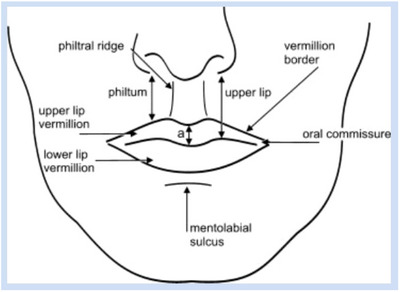
Drawing depicting the major anatomic landmarks of the lips and mouth (from Carey et al., 2009).
The lips are mainly pigmented by hemoglobin, as well as melanin in lesser quantities. 14 Lip color can be modulated by age, 15 ethnicity, 14 , 16 hormonal status, 17 and external factors such as tobacco use. 18 The lips can present pigmentation irregularities, such as darker lips due to melanin accumulation in the epidermis basal layer 19 or vitiligo. 20
Skin and lip color can be evaluated through different assessment methods, from visual and clinical scoring to quantitative and noninvasive instrumental measurements, such as colorimeters and spectrophotometers. Colorimeters are objective color quantification tools that represent human color vision, whereas spectrophotometers measure the spectral reflectance of visible wavelengths, from 400 mm to 700 mm, to obtain color information. 21 Spectrophotometers are widely used for investigating skin color as they can offer a contactless noninvasive method that provides full spectral reflectance information, allowing precise color coordinates computation and metamerism effects investigation. Metamerism is a phenomenon where two objects with different spectral reflection may produce the same perception of color under one illuminant (illuminant metamerism) or for one observer (observer metamerism). 22
Measuring skin color has become a topic of great interest, partly due to the increasing availability and improved accuracy of photo‐based color measuring devices, such as the VISIA‐CR® from Canfield Scientific Inc. and many studies have shown the impact of skin components on skin color as well as ethnicities, seasonal, or age difference factors. Skin color heterogeneity has also been investigated across ethnicities and ages. 23, 24 In contrast, lip color measurement and characterization are less documented in literature, most likely in part due to the relief and size of the lips, which render the area difficult for color measurement.
The accurate measurement and reproduction of lip color are essential to build future strong international knowledge about lip color. The present experiment was designed to use more than one contactless tool to measure the same anatomical regions to assess the measuring repeatability, intercomparison, and color distribution between different instruments. This preliminary experiment of a large‐scale project on lip and skin color measurement is aimed at investigating the accuracy of lip color measurement and recommend instruments and protocols for good measurement practice.
2. METHODS
2.1. Subjects
The study involved 19 healthy French Caucasian women, phototypes I to III on the Fitzpatrick Skin Type scale. 25 The volunteers were aged from 21 to 67 years (mean = 43.3; standard deviation = 14.7) including four women in the age range of 18–28 years, four women in the age range of 29–38 years, three women in the age range of 39–48 years, four women in the age range of 49–58 years, and four women in the age range of 59–68 years.
The women were selected based upon their use of selective lipsticks at least twice a week. Exclusion criteria were any surgical procedures on the face and any tattooing of the lips. The volunteers were instructed not to apply any lip product (moisturizer or makeup) from the evening prior to their appointment.
All participants were informed of the objective of the study, signed an informed consent form including image rights upon their arrival, and received a gift for their participation at the end of the test.
3. EXPERIMENTAL ACQUISITION DEVICE
3.1. spectrophotometer VS3200
Lip color was measured with a 45°/0° (45° ring illumination, 0° reception) imaging spectrophotometer (MetaVue VS3200, X‐Rite Inc.), which measures a target area in less than 10 s using a digital camera and full spectrum LED illumination from 400 to 700 nm with a measurement interval of 10 nm. For the color computation from the spectrum, the spectrophotometer was configured with D65 illuminant and 10° observer. The D65 illuminant corresponds to the average midday light and is often used as a reference illuminant for colorimetric measurement and analysis, and the 10° observer corresponds to a standard human observer with a view angle of 10°. 22
3.2. Photos VISIA‐CR®
Frontal and 37° profile view facial photographs were captured using a standard imaging device based on a high‐resolution digital camera (VISIA‐CR®, Canfield Scientific Inc.) under general standard white, cross‐polarized and parallel‐polarized lighting conditions. A specific 48‐patch color chart was added to the system to allow color calibration of the images afterwards. Figure 2 presents an example of the images acquired using VISIA‐CR® under the three different lighting conditions.
FIGURE 2.
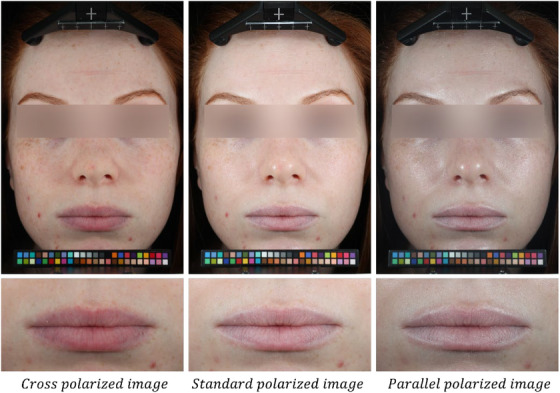
VISIA‐CR® images under three different lighting conditions. Top row: full‐face images. Bottom row: corresponding lips details.
3.3. SpectraFace®
In addition to well‐known tools such as the spectrophotometer and VISIA‐CR®, a full‐face hyperspectral imaging system, SpectraFace® (Newtone Technologies), was included in the protocol as an interesting outsider. 26 Because it combines both spectral measurement and imaging, it may offer an interesting merging of the added values of both approaches. This is the first time that the SpectraFace is used for lips color measurements.
The SpectraFace device, shown in Figure 3, is based on a high‐resolution monochrome camera (2048 × 2048 pixels) and a liquid crystal tunable filter (LCTF) allowing to select 30 wavelengths from 410 to 700 nm with an interval of 10 nm. Two lighting pods, located on both sides, homogeneously illuminate the subject face. The system is equipped with polarization filters in cross position to remove specular reflection and ensure relevant color analysis. The 30 individual images are captured sequentially within 3 s, limiting subject movement during the acquisition. The stack of these 30 2D monochrome images acquired at different wavelengths results in a hyperspectral image, with spectral information available in each pixel.
FIGURE 3.
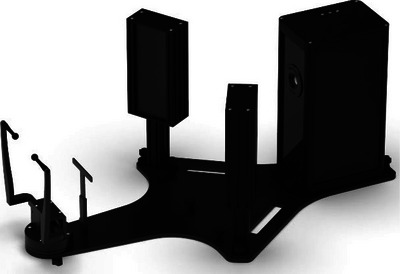
SpectraFace® system.
Figure 4 presents an example of single images at three different wavelengths (420, 590, and 700 nm) acquired using the SpectraFace®. They show how skin properties vary according to wavelength, with melanin spots easily identifiable at blue wavelengths (420 nm), blood vessels highly visible at 590 nm, and the skin appearing very uniform in red wavelengths (700 nm)—the range of the visible spectrum for which skin is the most translucent.
FIGURE 4.
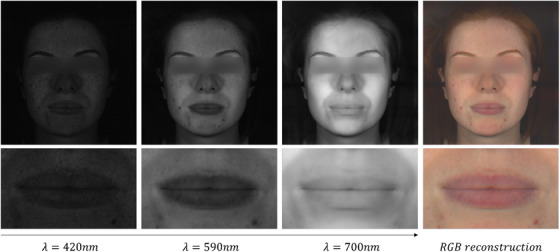
Single images at three different wavelengths and standardized RGB color image. Top row: full‐face images. Bottom row: corresponding lips details.
Using the spectral information available in each pixel, it is possible to compute RGB color coordinates given a specific illuminant and observer, resulting in a standardized RGB color image. As for the spectrophotometer, the D65 illuminant and 10° observer were used as standard conditions for color computation. The resulting color image is a strict conversion of the spectral reflectance without any posttreatment or color enhancement applied, contrary to most other commercial devices. There is no specular reflection on the resulting color reconstruction, due to the cross‐polarization.
The particular rendering of the SpectraFace® color reconstruction, less “sharp” in comparison with other instrument such as VISIA‐CR®, is due to the absence of posttreatment and to the cross‐polarization. It is also possible that the lower spatial resolution of the images (110 μm for the SpectraFace® vs. 33 μm for VISIA‐CR®) may give the impression of blurriness.
Figure 5 presents an example of the mean spectral reflectance on the inferior lips on three different subjects. The curved lines show that the reflectance is quite low between 400 and 600 nm meaning that the lips absorb the blue and green wavelengths of the spectrum, whereas the reflectance is higher between 600 and 700 nm, meaning that the lip reflects the red wavelengths. The fact that the lips absorb the blue and green wavelengths and reflect the red wavelengths explain that the lips appear mainly red to human eyes.
FIGURE 5.

Spectral reflectance of the lower lips of three different subjects using SpectraFace® device (Newtone Technologies).
All the three devices were selected specifically because they do not involve contact measurements that could alter blood flow by applying pressure on the lips and thus alter the color. Nevertheless, the sensor, the measurement geometry, and the lighting emission and polarization are different across the devices.
4. HUMAN LIP COLOR MEASUREMENT
4.1. Measurements
Measurements were taken in a room with standardized temperature (21°C ± 3°C). At the beginning of the appointment, each woman cleansed her face and lips with makeup remover, toner, and thermal water to remove any trace of makeup product. Each of the 19 women came twice, 1 week apart, to assess the repeatability performance of the measurement. Measures were taken on bare lips. The color was recorded on the inferior and superior lips within defined areas of a diameter of respectively 5 mm (3 mm for two subjects with very fine lips) and 3 mm for the spectrophotometer (Figure 6) and 8.2 mm2 for the VISIA‐CR® and the SpectraFace® pictures (Figure 7).
FIGURE 6.
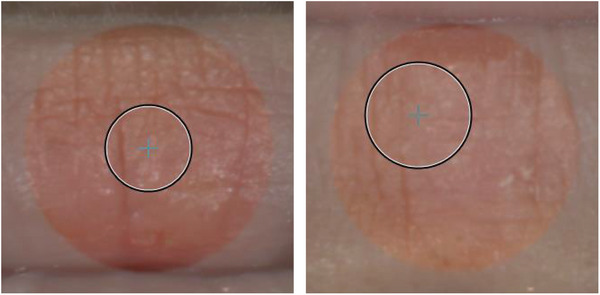
Regions of interest defined on superior (left image) and inferior (right image) lips on spectrophotometer VS3200 within defined areas of a diameter of respectively 3 and 5 mm (3 mm for 2 subjects with very fine lips).
FIGURE 8.
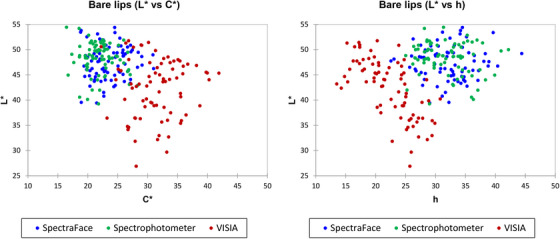
Data for the three devices, two repetitions, and two areas (inferior and superior lip) in Cab*‐L* and hab‐L* planes.
FIGURE 7.

Regions of interest defined on superior and inferior lips on VISIA‐CR® (left image) and SpectraFace® (right image) images within defined areas of 8.2 mm2.
4.2. Analysis
From the VISIA‐CR® acquisitions, colorimetric analysis was performed on the cross‐polarized images within the defined regions of interest for both the superior and inferior lips.
From the SpectraFace® acquisitions, the hyperspectral images were first calibrated using reference white and black measurements and the color reconstruction under D65 illuminant and 10° observer was computed. This color reconstruction is converted to RGB for visualization and to Lab for parameter computation.
Colorimetric analysis was then performed on the Lab color reconstruction within the defined regions of interest for both the superior and inferior lips.
All three devices allow to extract standard colorimetric parameters lightness (L*), chroma (C*) and hue (h) and were expressed in the CIE 1976 standard colorimetric space: L*, a*, b*, C*, and h.
4.3. Statistics
In total, 228 data points (19 women, 2 visits, 3 tools, and 2 areas of measurement) for each L*, a*, b*, C*, and h parameter were collected. Data analysis was performed using XLStat software (Addinsoft). Preliminary to data analysis, the initial stage of the results involved the repeatability of the three instruments. The three‐factor ANOVA (device × repetition × area) with level 2 interaction and Newman Keuls post hoc tests 27 showed that all three instruments were repeatable on all the variables at the 5% threshold between the devices for the LabCh variables (p value ≥0.644 for all the variables). The differences between instruments and lip areas were demonstrated using univariate analysis (three‐factor ANOVA (device × repetition × area) with level 2 interactions) on L*, a*, b*, C*, and h data. Newman Keuls post hoc tests were made to detect any statistical differences and a p value < 0.05 was considered statistically significant. Results are expressed on the tables and graphs as mean ± standard error of the mean for each group The lip tone characterization was made using principal component analysis (PCA) and a hierarchical ascending classification (HAC) 28 from ‐L*, a*, b*, C*, and h data on bare lips (upper and lower) for the SpectraFace® data only.
5. RESULTS
Table 1 shows the mean, standard deviation, and significant differences at the 5% threshold between the devices for the LabCh variables and all subjects. This analysis highlights that even if the three devices have a similar global mean for each variable, they are not strictly identical. The VISIA‐CR® has the lowest L*, the highest a*, the highest C* and the lowest h; the spectrophotometer has the lowest a* and the lowest C*; and the SpectraFace® has an intermediate a* and C*. Except for the b* variable, the difference is consistently greater for the VISIA‐CR® in comparison to the other two devices.
TABLE 1.
Summary of LabCh means and standard deviation by device from three‐factor ANOVA (device × repetition × area) with level 2 interaction and Newman Keuls post hoc tests.
| L* | a* | b* | C* | h | ||||||
|---|---|---|---|---|---|---|---|---|---|---|
| Mean | Standard deviation | Mean | Standard deviation | Mean | Standard deviation | Mean | Standard deviation | Mean | Standard deviation | |
| SpectraFace® | 47.360 a | 3.366 | 20.024 b | 2.856 | 12.539 a | 1.767 | 23.684 b | 2.922 | 32.190 a | 4.064 |
| spectrophotometer | 48.288 a | 3.171 | 18.608 c | 2.278 | 11.546 b | 1.815 | 21.948 c | 2.513 | 31.829 a | 3.876 |
| VISIA‐CR® | 42.311 b | 5.781 | 29.031 a | 3.845 | 11.931 ab | 2.729 | 31.469 a | 4.126 | 22.284 b | 4.247 |
| F | 64.290 | 331.304 | 4.235 | 213.442 | 180.316 | |||||
| Pr > F | < 0.0001 | < 0.0001 | 0.016 | < 0.0001 | < 0.0001 | |||||
The presence of two different letters indicates a significant difference for the same variable at the 5% level.
Figure 8 compares the data between the three measurements on two different planes, Cab*, L*, and hab‐L*, on bare lips. The data for the SpectraFace® and the spectrophotometer are close and overlap. The VISIA‐CR® had higher chroma values and lower lightness values. Hue results were also lower for the VISIA‐CR® compared to the SpectraFace® and the spectrophotometer.
Figure 9 shows the discriminating ability between the analysis areas (lower and upper lip) per device. The VISIA‐CR® results highlight a lower lip that is lighter, redder, and more saturated than the upper lip. The SpectraFace® results highlight a lower lip that is lighter, redder, and more saturated than the upper lip. The spectrophotometer results highlight a lower lip that is redder than the upper lip. Among the devices, the spectrophotometer discerns less differences between the two areas of measurement as it can only differentiate the upper and lower lips on the a* and h variables.
FIGURE 9.
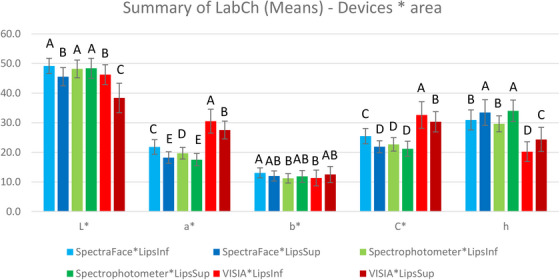
Summary of LabCh means by device and area from three‐factor ANOVA (device × repetition × area) with level 2 interaction and Newman Keuls post hoc tests. The presence of two different letters indicates a significant difference for the same variable at the 5% level.
As expected, these preliminary results revealed some color differences between the measurement tools, due to their intrinsic characteristics. This also yielded an initial investigation of lip color diversity. Nevertheless, such analyses do not highlight segmented lip color typologies, which motivated us to distinguish groups in our lip color space. It was decided to create clusters from the SpectraFace® data, because its precision is close to the spectrophotometer, and the location of the measurement can be precisely defined.
Classification based on the L*, a*, b*, C*, and h data on bare lips (superior and inferior) emphasized three groups of lip tones (Table 2a and b and Figure 10). The first group is composed of nine women with a darker and redder inferior lip. The second group is composed of seven women with a lighter and yellower inferior lip and a yellower superior lip. The three women constituting the third group have an inferior lip tone as light as the second group and as red as the first group with a redder superior lip. It is interesting to note that there is no statistical difference in chroma for the superior and inferior lip between the groups.
TABLE 2.
Summary of ‐LabCh means and standard deviation by group from one‐factor ANOVA (Group) and Newman Keuls post hoc tests (a. inferior lip; b. superior lip).
| a. | ‐L* lip inferior | a* lip inferior | b* lip inferior | C* lip inferior | h lip inferior | |||||
|---|---|---|---|---|---|---|---|---|---|---|
| Mean | Standard deviation | Mean | Standard deviation | Mean | Standard deviation | Mean | Standard deviation | Mean | Standard deviation | |
| Group 1 (9 women) | ‐47.391 a | 0.618 | 23.323 a | 0.614 | 13.159 a | 0.481 | 26.796 a | 0.742 | 29.380 b | 0.520 |
| Group 2 (7 women) | ‐50.752 b | 0.701 | 19.930 b | 0.696 | 13.515 a | 0.545 | 24.107 a | 0.841 | 34.087 a | 0.589 |
| Group 3 (3 women) | ‐50.865 b | 1.070 | 21.746 ab | 1.063 | 11.699 a | 0.833 | 24.706 a | 1.285 | 28.291 b | 0.900 |
| F | 7.945 | 6.686 | 1.704 | 3.084 | 23.092 | |||||
| Pr > F | 0.004 | 0.008 | 0.213 | 0.074 | < 0.0001 | |||||
| b. | ‐L* lip superior | a* lip superior | b* lip superior | C* lip superior | h lip superior | |||||
| Mean | Standard deviation | Mean | Standard deviation | Mean | Standard deviation | Mean | Standard deviation | Mean | Standard deviation | |
| Group 1 (9 women) | ‐43.555 a | 0.764 | 18.867 a | 0.554 | 12.130 a | 0.443 | 22.446 a | 0.634 | 32.685 b | 0.850 |
| Group 2 (7 women) | ‐46.560 ab | 0.867 | 17.143 a | 0.629 | 12.870 a | 0.502 | 21.464 a | 0.719 | 36.941 a | 0.963 |
| Group 3 (3 women) | ‐49.137 b | 1.324 | 18.823 a | 0.960 | 9.702 b | 0.767 | 21.229 a | 1.098 | 27.526 c | 1.472 |
| F | 7.755 | 2.346 | 6.021 | 0.741 | 15.071 | |||||
| Pr > F | 0.004 | 0.128 | 0.011 | 0.492 | 0.000 | |||||
The presence of two different letters indicates a significant difference for the same variable at the 5% level.
FIGURE 10.

Representation of the three groups of lip color highlighted by HAC (hierarchical ascending classification) based on the L*, a*, b*, C*, and h data on bare lips (superior and inferior) (SpectraFace® images). Group 1: darker and redder inferior lip. Group 2: lighter and yellower inferior lip and yellower superior lip. Group 3: inferior lip tone as light as the second group and as red as the first group with a redder superior lip.
6. DISCUSSION AND CONCLUSION
Preliminary to an ongoing large‐scale project of lip and skin color measurement, the objective of this work was to recommend instruments and protocols for good measurement practices on the lip area, which is less documented in literature. The present experiment therefore considered the measurement of lip color via three different instruments to assess the intercomparison and color distribution between the different instruments and the measuring repeatability of each one.
The three tools reached the same conclusion regarding the lip color heterogeneity as the inferior lip tended to be lighter, redder, less yellow, and more saturated than the superior lip, although these differences were more visible with the VISIA‐CR®. To our knowledge, these observations are quite innovative, as the study of lip color heterogeneity is a poorly documented topic in the literature, especially among one unique ethnic group. Certain authors have mentioned, for instance, that the Cupid's bow appears lighter due to the anatomic configuration of the underneath muscle. 29 Some Asian women complain of a dull color of the lips, more accentuated in the corners versus the center of the lips. 14 This dullness would be associated with a low cutaneous blood flow and a reduced saturation of hemoglobin in the oxygen. For hydration level, Caisey et al. in 2008 30 showed that the inner section of the lip mucosa is less hydrated than the external section, highlighting an internal structure clearly different across vermilion areas.
Agreement between the SpectraFace® and the spectrophotometer measurements was higher, with the VISIA‐CR® results showing higher chroma, lower lightness, and lower hue. It is important, however, to keep in mind certain limitations in comparing color measurement instruments in terms of settings such as illuminant, colorimetric system, specular component, and measurement geometry. 21 Indeed, the results presented here are given for a defined illuminant (D65 for both the spectrophotometer and the SpectraFace and D65 equivalent for the VISIA‐CR) and could be slightly different under another illuminant. However, the SpectraFace should stay close to the spectrophotometer, despite metamerism effects, as they both capture the full reflectance information to measure the color. The difference in the size and the position of the region of interest (8.2 mm2 for the SpectraFace® vs. 20 mm 2 for the spectrophotometer with less precision in the positioning) can also explain the remaining color difference.
Finally, even if, because of the small size of the panel, the results are to be considered more as an illustration of what could be achieved on a larger scale, the SpectraFace® allowed to identify three separated lip color typologies, one characterized by lighter and redder lips, one by lighter and yellower lips and one by darker and redder lips, with no difference in chroma between the three typologies. These differences are statistically significant, but the small number of women in each group is a limitation and gives trends more than real typologies. A wider study must be made to asset these groups. Moreover, the Caucasian lip color range appears to be quite limited. Investigation across ethnicity will be of great interest to extend the lip color range and the lip color typologies.
The three‐color measurement tools were selected for this experiment because they are contactless tools, which is important when measuring in vivo color. Indeed, contact measurement tools are known to lead to a redder color due to the pressure applied to the skin, whereas in general, noncontact measurements lead to a darker measured color, with good agreement in hue angle. 31 Moreover, for hygienic concerns, it seems crucial to develop noninvasive contactless measurement tools, especially for lip investigation.
Short acquisition time and uniform lighting conditions to avoid shadowing are crucial for an accurate in vivo color measurement, especially for a small facial region such as the lips, where the movements of the subject and the lip relief can lead to outlier results. Indeed, the relief of the lips makes them a little bit more challenging to measure than flat skin because it might create some shadows that can affect color measurement. To limit that, the measure was done on a small region of interest and located on the fullest part of the lips, avoiding lips ridges and corner. So, with post measurement image analysis, the VISIA‐CR® and the SpectraFace® avoid these problems because the lip area can be precisely selected. The measurement area cannot be precisely controlled with the spectrophotometer, which is a minor issue when measuring skin, because the area of interest is larger; however, the lip area is very small in comparison to the size of the measurement zone of the Spectrophotometer.
In conclusion, the combination of imaging technology to obtain spatial information with all the possibilities of analysis that it offers (positioning/repositioning of the region of interest, computation of evenness etc.), and hyperspectral measurement for the relevance of color data, makes the SpectraFace® a useful additional tool for skin and lip spectral color characterization (see Table 3 for a summary), complementary to standardized, easy to use and to deploy, photo‐based color measuring devices such as the VISIA‐CR®.
TABLE 3.
Summary table of advantages/disadvantages of each device.
| VISIA‐CR® | Spectrophotometer | SpectraFace® | |
|---|---|---|---|
| Ease of use and deployment | ++ | + | –/+ |
| Standard tool of colorimetric visualization and measurement | Standard tool of spectral color measurement but rather adapted to in vitro measurement | Nonstandard, innovative tool of spectral color measurement | |
| Color measurement technology | –/+ | ++ | ++ |
| RGB color measurement within the illuminant of the VISIA, not compliant with D65 color measures | Spectral reflectance measurement allowing standardized color measure, compliant with D65 color measures | Spectral reflectance measurement allowing standardized color measure, compliant with D65 color measures | |
| Measurement type | ++ | –/+ | + |
| Imaging: Spatial information available | Spot measurement | Imaging: Spatial information available | |
| (resolution: 34 μm) | (diameter of the spot: 5 mm) | (resolution: 110 μm) | |
| Region of interest | ++ | –/+ | ++ |
| Possibility to define specific region of interest with different size and locations | Spot measurement | Possibility to define specific region of interest with different size and locations | |
| Repeatability | ++ | ++ | ++ |
| Good repeatability | Good repeatability | Good repeatability | |
| Discriminability | ++ | –/+ | ++ |
| Significant difference between superior and inferior lips in L*, a*, C* | Significant difference between superior and inferior lips in a* | Significant difference between superior and inferior lips in L*, a*, C* | |
| Capture time | ++ | – | + |
| Immediate | 10 s | Approximately 3 s | |
| Simulation of illuminants | –/+ | + | ++ |
| Only the illuminant of the system | Conversion of color data under other illuminants, but no associated image | Creation of images under other illuminants |
Although publications on the topic of lip color measurement are less numerous than those for skin color measurement, some authors have investigated the impact of ageing, showing that lips tended to be less red and darker with age. 17 , 32 , 33 Similarly, the impact of ethnicity on lip color has been observed by few authors, reporting similarities and differences between ethnic groups. 16 , 34 With only 19 Caucasian women in this experiment, it was impossible to investigate the effects of age and ethnicity. With a large‐scale project, including more women from various age groups and ethnicities, we will confirm whether the SpectraFace® measurement yields the same conclusions.
As mentioned in the introduction, the lips play a significant role in facial perception and lip color could impact skin color perception, 35 , 36 attractiveness and age perception, mostly through the modulated appreciation of contrasts. 37 Conclusions regarding the impact of facial contrast on perceived age are cross‐cultural. 38 For the lips, Baras et Caisey in 2016 16 showed the varying contrasts between the vermilion border and the perilabial skin, from sharp differences to matching tones, with some similarities and differences across ethnicities. An inclusive large‐scale project to consider the overall facial color harmony, for instance, lip and skin color, is therefore of great interest.
While lip color is one crucial factor, as we previously stated, the lips are characterized by shape, color, and relief. All of these characteristics could be taken into account for an exhaustive lip characterization as they can impact perceived facial attractiveness 39 and could also be a key point for the ideal lip definition across cultures. 40
By extension, lip cosmetic products, as modulator tools, can interfere with perceived facial characteristics. Balms, lipsticks, and lip glosses are essential to a women's makeup, used to highlight individuality, character, seductive capacity, and underline the smile. 41 Balms, lipsticks, and glosses can add color, nourish the lips, and give them a light, supple appearance, and a long‐lasting sparkle. These modifications will also undoubtedly have a deleterious impact on the color measurement, which must be taken into account.
In conclusion, the future inclusive large‐scale project will attempt to investigate lip and skin color, using spectral and nonspectral color measurement, to consider color contrast between these two elements. It will characterize lips not only by color but also by shape, relief, and hydration data. This international study will further understanding of the skin and lip typologies linked to makeup strategies.
FUNDING INFORMATION
This work was supported by LVMH Recherche.
CONFLICT OF INTEREST STATEMENT
MC and GF are full‐time employees of Newtone Technologies, a company specialized in the design of innovative solutions for skin imaging and analysis. HV, ZC, EL, and GG are a full‐time employees of LVMH Recherche, a company dedicated to cosmetic products. LC is an employee of Boostinnov, a company dedicated to cosmetic product innovation.
ACKNOWLEDGMENTS
We would like to thank Virginie Couturaud, Scientific Communication Director at Parfums Christian Dior, for her relevant comments and expertise. We also would like to thank X‐Rite Inc., and especially Lawrence Warmby, who helped us to put in place the spectrophotometer VS3200 for a lip color spectral measurement.
Vergnaud H, Cherel M, Francois G, et al. Lip color measurement: A new hyperspectral imaging device. Skin Res Technol. 2023;29:ert13418. 10.1111/srt.13418
DATA AVAILABILITY STATEMENT
The data that support the findings will be available in Sharepoint at https://wwpcis‐my.sharepoint.com/:f:/r/personal/hvergnaud_research_lvmh‐pc_com/Documents/SALT/Publication%20N%C2%B01?csf = 1&web = 1&e = VGCgHV following an embargo from the date of publication to allow for commercialization of research findings.
BIBLIOGRAPHY
- 1. Korichi R, Pelle‐de‐Queral D, Gazano G, Aubert A. Why women use make‐up? Psychological identification of underlying mechanisms in the use of make‐up. J Cosmet Sci. 2008;59:127‐137. PMID: 18408870 [PubMed] [Google Scholar]
- 2. Walker‐Smith GJ, Gale AG, Findlay JM. Eye movement strategies involved in face perception. Perception. 1977;6:313‐326. [DOI] [PubMed] [Google Scholar]
- 3. Pelphrey KA, Sasson NJ, Reznick JS, Paul G, Goldman BD, Piven J. Visual scanning of faces in autism. J Autism Dev Dis. 2002;32:249‐261. [DOI] [PubMed] [Google Scholar]
- 4. Lundqvist D, Ohman A. Emotion regulates attention: The relation between facial configurations, facial emotion, and visual attention. Visual Cognition. 2005;12(1):51‐84. [Google Scholar]
- 5. Henderson JM, Brockmole JR, Castelhano MS, Mack M. Visual saliency does not account for eye movements during visual search in real‐world scenes. In van Gompel R, Fischer M, Murray W, Hill R, eds. Eye Movements: A Window on Mind and Brain. Oxford: Elsevier; 2007:537–562. [Google Scholar]
- 6. Nguyen HT, Isaacowitz DM, Rubin PA. Age‐and fatigue‐related markers of human faces: an eye‐tracking study. Ophthalmology. 2009. 116(2):355‐360. [DOI] [PubMed] [Google Scholar]
- 7. Nomura N, Hikima R, Fukuda R. Proposing a new “eye‐catch” makeup concept—human impressions alter by visual guidance using makeup. Paper presented at the 26th Congress of the International Federation of Societies of Cosmetic Chemists, 30‐23 September in Buenos Aires, Argentina; 2010.
- 8. Nkengne A, Bertin C, Stamatas GN, et al. Influence of facial skin attributes on the perceived age of Caucasian women. J Eur Acad Dermatol Venereol. 2008;22(8):982‐991. [DOI] [PubMed] [Google Scholar]
- 9. Gunn DA, Rexbye H, Griffiths CE, et al. Why some women look young for their age. PLoS One. 2009;4(12):e8021. [DOI] [PMC free article] [PubMed] [Google Scholar]
- 10. Stephen ID, McKeegan AM. Lip colour affects perceived sex typicality and attractiveness of human faces. Perception. 2010;39(8):1104‐1110. [DOI] [PubMed] [Google Scholar]
- 11. Russell R. Sex, beauty, and the relative luminance of facial features. Perception. 2003;32(9):1093‐1107. [DOI] [PubMed] [Google Scholar]
- 12. Carey JC, Cohen MM Jr, Curry CJ, Devriendt K, Holmes LB, Verloes A. Elements of morphology: standard terminology for the lips, mouth, and oral region. Am J Med Genet Part A. 2009;149(1):77‐92. [DOI] [PubMed] [Google Scholar]
- 13. Foutsizoglou S. Anatomy of the ageing lip. Plastic Maxillo‐Facial Surg Aesth Med News. 2017;4:1‐3. [Google Scholar]
- 14. Iwai I, Yamashita T, Ochiai N, Masuda Y, Hosokawa K, Kohn o Y. Can daily‐use lipstick make lips more fresh and healthy?—A new lipstick containing glucosyl hesperidin can remove the dull‐color from lips. Proceedings of the SCSK Conference. KoreaScience; 2003:162‐177.
- 15. Tamura Y, Shibukawa Y, Shintani M, Kaneko Y, Ichinobe T. Oral structure representation in human somatosensory cortex. Neuroimage. 2008;43:128‐135. [DOI] [PubMed] [Google Scholar]
- 16. Baras D, Caisey L. Skin and lip typology. In Kelly A, Taylor SC, Lim HW, Serrano A, eds. Taylor and Kelly's Dermatology for Skin of Color. McGraw Hill; 2016:2e, 541–551. [Google Scholar]
- 17. Caisey L, Gubanova E, Camus C, Lapatina N, Smetnik V, Lévêque JL Influence of age and hormone replacement therapy on the functional properties of the lips. Skin Res Technol. 2008;14:220‐225. [DOI] [PubMed] [Google Scholar]
- 18. Sarswathi TR, Kumar SN, Kavitha KM. Oral melanin pigmentation in smoked and smokeless tobacco users in India. Clinico‐pathological study. Indian J Dent Res. 2003;14(2):101‐106. [PubMed] [Google Scholar]
- 19. Kunachak S, Kunachakr S, Kunachark S, Leelaudomlipi P, Wongwaisatawan S. An effective treatment of dark lip by frequency‐doubled Q‐switched Nd:YAG laser. Dermatol Surg. 2001;27:37‐40. [PubMed] [Google Scholar]
- 20. Babu A, Thappa DM, Jaisankar TJ. Punch grafting versus suction blister epidermal grafting in the treatment of stable lip vitiligo. Dermatol Surg. 2008;34:166‐178. [DOI] [PubMed] [Google Scholar]
- 21. Ly BCK, Dyer EB, Feig JL, Chien AL, Del Bino S. Research techniques made simple: cutaneous colorimetry: a reliable technique for objective skin color measurement. J Invest Dermatol. 2020;140(1):3‐12.e1. [DOI] [PubMed] [Google Scholar]
- 22. Ohta N, Robertson A. Colorimetry: Fundamentals and Applications. John Wiley & Sons; 2006. [Google Scholar]
- 23. Rigal J, Diridollou S, Querleux B, Yang G, Leroy F, Barbosa V. The effect of age on skin color and color heterogeneity in four ethnic groups. Skin Res Technol. 2010;16:168‐178. [DOI] [PubMed] [Google Scholar]
- 24. Qiu H, Long X, Ye JC, et al. Influence of season on some skin properties: winter vs. summer, as experienced by 354 Shanghaiese women of various ages. Int J Cosmet Sci. 2011;33(4):377. PMID: 21382055 [DOI] [PubMed] [Google Scholar]
- 25. Fitzpatrick TB. The validity and practicality of sun‐reactive skin types I through VI. Arch Dermatol. 1988;124(6):869‐871. [DOI] [PubMed] [Google Scholar]
- 26. Gevaux L, Gierschendorf J, Rengot J, et al. Real‐time skin chromophore estimation from hyperspectral images using a neural network. Skin Res Technol. 2021;27(2):163‐177. [DOI] [PubMed] [Google Scholar]
- 27. Howell D. Statistical Methods for Psychology (4th edn.). Wadsworth Publishing Company; 1997. [Google Scholar]
- 28. Härdle W, Simar L. Applied Multivariate Statistical Analysis (3rd edn.). Springer Verlag; 2012. [Google Scholar]
- 29. Mulliken JM, Pensler JM, Kozakewich HPW. The anatomy of Cupid's bow in normal and cleft lip. Plast Reconstr Surg. 1993;92(3):395‐403. [PubMed] [Google Scholar]
- 30. Caisey L, Gubanova E, Baras D, Lévêque JL. Unexpected distribution of surface hydration level of the lip. J Eur Acad Dermatol Venereol. 2008;22(10):1159‐1162. [DOI] [PubMed] [Google Scholar]
- 31. Wang M, Xiao K, Wuerger S, Cheung V, Luo MR. Measuring human skin colour. In Color and Imaging Conference. Society for Imaging Science and Technology; 2015:230–234.
- 32. Kim H, Lee M, Park SY, Kim YM, Han J, Kim E. Age‐related changes in lip morphological and physiological characteristics in Korean women. Skin Res Technol. 2019;25(3):277‐282. [DOI] [PubMed] [Google Scholar]
- 33. Tamura E, Ishikawa J, Sugata K, Tsukahara K, Yasumori H, Yamamoto T. Age‐related differences in the functional properties of lips compared with skin. Skin Res Technol. 2018;24(3):472‐478. [DOI] [PubMed] [Google Scholar]
- 34. Wee AG, Beatty MW, Gozalo‐Diaz DJ, Kim‐Pusateri S, Marx DB. Proposed shade guide for human facial skin and lip: a pilot study. J Prosthet Dent. 2013;110(2):82‐89. [DOI] [PubMed] [Google Scholar]
- 35. Kobayashi Y, Matsushita S, Morikawa K. Effects of lip color on perceived lightness of human facial skin. i‐Perception. 2017;8(4):204166951771750. [DOI] [PMC free article] [PubMed] [Google Scholar]
- 36. Kiritani Y, Okazaki A, Motoyoshi K, Takano R, Ookubo N. Color illusion on complexion by lipsticks and its impression. Jpn J Psychonom Sci. 2017;36(1):4‐16. [Google Scholar]
- 37. Porcheron A, Mauger E, Russell R. Aspects of facial contrast decrease with age and are cues for age perception. PLoS One. 2013;8(3):e57985. [DOI] [PMC free article] [PubMed] [Google Scholar]
- 38. Porcheron A, Mauger E, Soppelsa F, et al. Facial contrast is a cross‐cultural cue for perceiving age. Front Psychol. 2017;8, 1208. [DOI] [PMC free article] [PubMed] [Google Scholar]
- 39. Lewandowski Z, Danel DP. Facial attractiveness and lip morphology of Caucasian women. AnthropologicAl Rev. 2018;81(4):404‐413. [Google Scholar]
- 40. Kollipara R, Walker B, Sturgeon A. Lip measurements and preferences in Asians and Hispanics: a brief review. J Clin Aesth Dermatol. 2017;10(11):19. [PMC free article] [PubMed] [Google Scholar]
- 41. Dong JK, Jin TH, Cho HW, et al. The esthetics of the smile: a review of some recent studies. Int J Prosthodont. 1999;12:9‐19. [PubMed] [Google Scholar]
Associated Data
This section collects any data citations, data availability statements, or supplementary materials included in this article.
Data Availability Statement
The data that support the findings will be available in Sharepoint at https://wwpcis‐my.sharepoint.com/:f:/r/personal/hvergnaud_research_lvmh‐pc_com/Documents/SALT/Publication%20N%C2%B01?csf = 1&web = 1&e = VGCgHV following an embargo from the date of publication to allow for commercialization of research findings.


